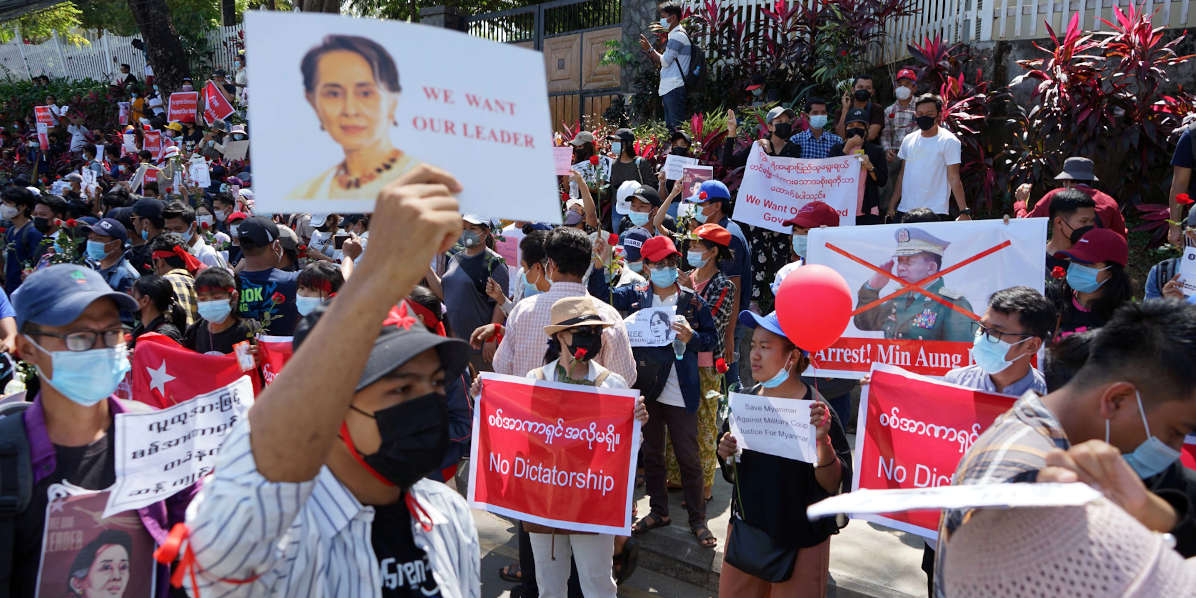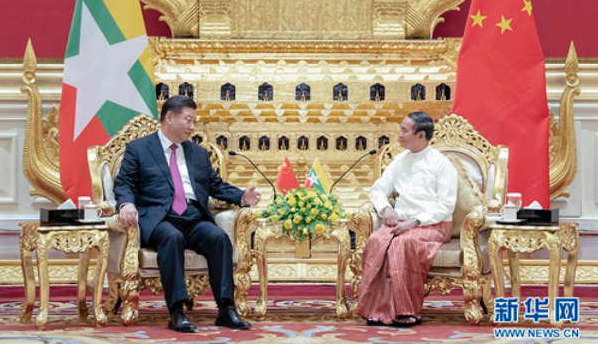En la imagen
Protesters against the 2021 coup, supporting their civil leader Aung San Suu Kyi [
1 February 2021 was just another day for the PE teacher Khing Hnin Wai who was shooting her regular work out video overlooking the road leading to Myanmar's parliament. Little did she know that her camera was accidentally capturing a military coup as it was underway. The world watched in horror as Myanmar fell into the grips of yet another military coup.
With the coup in February, General Min Aung Hlaing removed the democratically elected President Aung San Suu Kyi from power and held her under arrest. The junta has faced widespread condemnation and criticism from the ASEAN and other major global actors. But China has sensed an opportunity in the junta that would allow it to increase its influence in the region, especially in the ASEAN. This analysis seeks to examine the extent and the reasons for the Chinese involvement in Myanmar.
For a comprehensive analysis of the Chinese involvement in Myanmar, the essay will study the current Chinese activities in Myanmar by dividing it according to the type of objectives they seek. Firstly, economic objectives will be addressed, discussing the importance of Myanmar’s national economy, resources, and geographical position for the Chinese Belt and Road Initiative. Secondly, the Chinese political goals in the nation and region, as well as their impact on ASEAN and the Indo-Pacific, will be examined. Lastly, we will conduct an extensive exploration of what the Chinese agenda in Myanmar represents for the Indo-Pacific.
Background
Myanmar (former Burma) gained independence from the British Empire in 1948, and ever since, the state has faced difficulties in creating a stable political environment. Throughout its history, Myanmar has undergone multiple coups, revolutions, and uprisings. The civilian government placed the state of Myanmar under the caretaking of the military in 1958. But this caretaking role changed in 1962, when Maung Shu Mang Ne Win (Ne Win), a prominent Burmese military man and socialist politician, led a coup d’état that was to significantly shape Myanmar’s future.
During the Ne Win era, which lasted from 1962 to 1988, the military ruled-Burmese government maintained a close relationship with the Communist Party of China. During this period, Burma introduced socialist policies imitating Mao’s agrarian reforms, such as the approval of the Enterprise Nationalization Law, and even tried to replicate China’s Cultural Revolution.
A brief interlude in the military rule came in 1990 when elections were to be held in the state. A strong opposition was provided by Aung San Suu Kyi and her party, the National League for Democracy (NLD), which won the election in 1990. Aung San Suu Kyi led an important uprising called 8888 in 1988. She was soon put under house arrest in 1989 by the military. Her imprisonment lasted until 1995. The civilian government's victory in the election was short-lived, as the military conducted another coup overthrowing her government and consolidating the military's position in power.
The years following the General Election saw an end to multiple local conflicts. In 1994, the Kachin Independence Army signed a cease-fire with the military government, followed by the disbandment of the Möng Tai Army in 1996. It seemed that Myanmar finally was on the path to peace and stability. Moreover, in 1997, Burma was officially admitted into the ASEAN and a complete national reconfiguration of the military government purged corrupt officials. Yet, the country was not fully open to democracy. Prominent leaders of the Army of Myanmar—self-proclaimed Tatmadaw, or Royal [Glorious] Armed Forces in Burmese—such as Than Shwe, Maung Aye, and Khin Nyunt remained in charge, which discarded a possible end to the military government in the country.
In September 2000, Aung San Suu Kyi was placed under house arrest after attempting to leave the city of Rangoon. She would remain imprisoned for 19 months, and after a brief period of liberty, would be put into house arrest yet again because of her detention during the 2003 Depayin Massacre in which a government-supported mob attacked an NLD caravan in the city of Depayin. Suu Kyi was present during the altercations and was arrested by members of the military. This period would represent the longest imprisonment she has gone through, she would not be freed until 2010.
In 2007, a steep increase in the price of fuel and basic commodities prompted nationwide discontent and protests. Moreover, in the city of Pakkoku, Bhuddist monks were beaten by government authorities during the same protests. In return, All Burma Monks Alliance demanded apologies as well as reduction of price hikes from the junta, which disregarded all accusations. Consequently, monk demonstrations began in Myanmar’s biggest cities and the government began a national crackdown, known as the Saffron Revolution.
Adding to this, in 2008 a local food crisis and a cyclone devastated the country, leaving over 140,000 people dead or missing. International criticism over the slow response to the crisis, as well as the dire political situation, forced the military government to prepare for another general election to be held in 2010 in the hopes that it would stabilize the country. First, a referendum was held in 2008 in regard to the validity of the constitution, which paved the way to the release of Aung San Suu Kyi from her home arrest two years later.
During the election process, the NLD did not participate, giving space to Thein Sein—a prominent member of the military junta—to run for the presidency. After renouncing his SDPC (State Development and Peace Council, the official name of the Military government) membership, he won the elections with his own party, the Union Solidarity and Development Party (USDP). During Sein's government, gradual reforms allowed the liberation of multiple political prisoners, including Suu Kyi, whose party presented for the by-elections of 2012. The NLD was victorious, and Suu Kyi became a member of the parliament.
In 2015, general elections were held for the second time since the 2008 constitutional reform. This time, the NLD participated and won by a landslide victory, in which Htin Kyaw, a close associate of Suu Kyi was elected president. NLD kept its position in power in the 2020 general election, in which Suu Kyi became the second civilian president in the history of Myanmar.
After the 2021 coup, the civilian government collapsed and up to this day, civil war continues between different national liberation movements and Aung Hlaing’s military government, often with material and economic support from different international actors.


